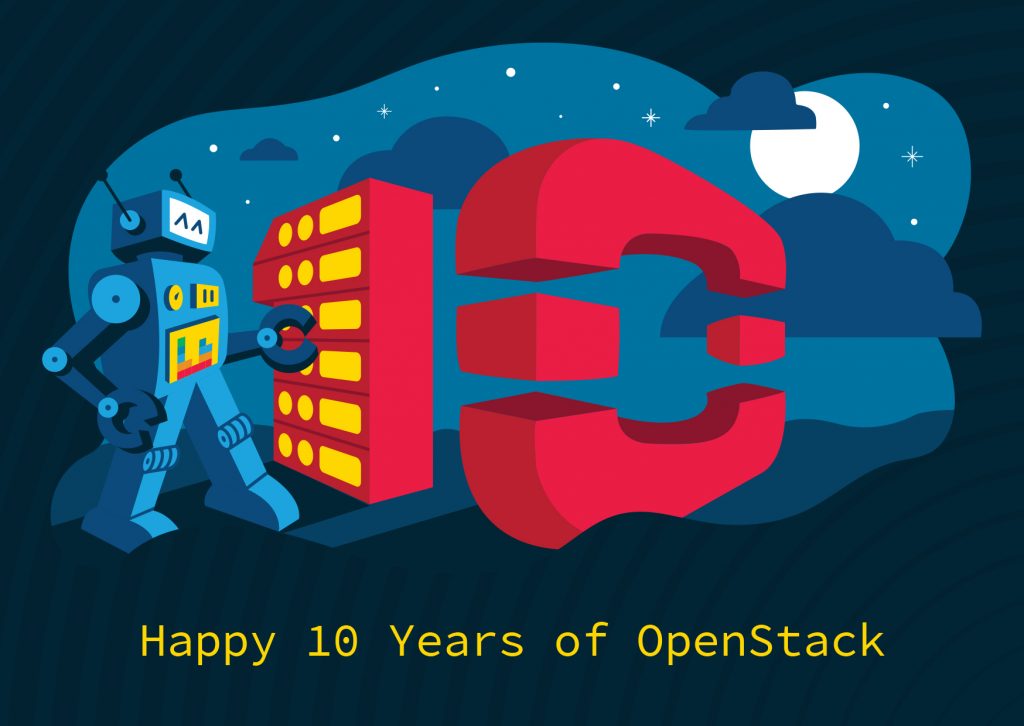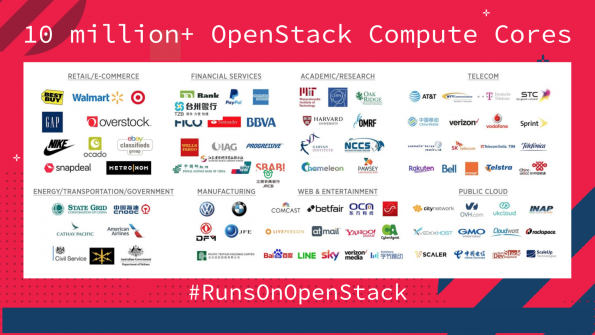Millions of cores, 100,000 community members, 10 years of you. Powering the world’s infrastructure, now and in the future. Thank you for the 10 incredible years of contribution and support.
Wow, 10-years’ today was when OpenStack was first launched. Many amazing tech milestones happened in 2010. Steve Jobs launched the first iPad. Sprint announced its first 4G phone. Facebook reached 500 million users. For us perhaps, one of the most important milestones was the birth of the OpenStack project in 2010.
In real time, the pace of change in the tech industry often feels glacial, but looking at things over a 10-year span, a lot of stark differences have emerged since 2010. So before you plug back your AirPods, fire up Fornite and watch a new show on Disney+, let’s take a look at how OpenStack has transformed the open source industry in the past 10 years.

The Decade Challenge—OpenStack Edition
What began as an endeavor to bring greater choice in cloud solutions to users, combining Nova for compute from NASA with Swift for object storage from Rackspace, has since grown into a strong base for open infrastructure. In 2010, three years before the OpenStack Summit Hong Kong, “the cloud” was barely a thing. Having a standardized, open source platform for public and private clouds was a dream. Now OpenStack is not only the de facto standard, but also a massive market that critical industries rely on.
Looking back to OpenStack in 2010, we were ecstatic to celebrate our first year of growth from a couple dozen developers to nearly 250 unique contributors in the Austin release (the first OpenStack release). Fast Forward to 2020, OpenStack ranks among the top three most active open source projects in the world, and is the most widely deployed open source cloud infrastructure software. Developers from around the world work together on a six-month release cycle with developmental milestones. 10 years in, OpenStack has had
- 21 on-time releases in 10 years, from “Austin” to “Ussuri”
- 451 Research projects a $7.7 billion USD OpenStack market by 2023, citing the most growth in Asia (36%), Latin America (27%), Europe (22%), and North America (17%).
- From two projects in 2010 to 42 projects in 2020
- Over 10 million cores in production
- 500,000+ changes merged
- 8,000+ individual developers authoring those changes
Every day, 900 changes are proposed and 18,000 tests are run to evaluate them.
Last year was a busy year for the open infrastructure community. The community combined 58,000 lines of code changes to support the output of more open source infrastructure software. In the same year, with 100,000 members and millions of visitors to the OpenStack website (check out the new homepage that we just launched, yay!), the community has made significant progress in supporting the goal of OpenStack’s $7.7 billion commercial market size worldwide and the future of over $12 billion OpenStack and container market by 2023.
The achievements of the global community in the past decade have been phenomenal. We are honored to work with many enthusiastic and talented individuals from all around the world to achieve the same goal, and also work together to build and operate open infrastructure.
Top 10 Favorites of OpenStack
There are so many milestones to celebrate in the past 10 years of OpenStack with our community. Here we have gathered some of the top 10 favorites of OpenStack from the community members around the world:
- Most Memorable OpenStack Moments—10 Years of OpenStack
- Most Unusual Place That an OpenStack Deployment Has Been Built—10 Years of OpenStack
- Most Used Features In OpenStack—10 Years of OpenStack
- Favorite Cities You’ve Visited for OpenStack—10 Years of OpenStack
- Favorite OpenStack Events—10 Years of OpenStack
- Favorite OpenStack Swag—10 Years of OpenStack
- First Contribution—10 Years of OpenStack
- First OpenStack Event—10 Years of OpenStack
- Predictions of OpenStack—10 Years of OpenStack
#ForTheLoveOfOpen
Throughout OpenStack’s history, we have been committed to creating an open culture that invites diverse contributions. Looking back to 10 years ago, we didn’t have enough experience to define what the “openness” means to us. In 2010, we described open source with the freedom to innovate, consume and redefine. Even though we didn’t have our “perfect” definition on “open” and “open source”, we drafted three commitments to our community in 2010:
COMMITMENT #1: We are producing truly open source software.
COMMITMENT #2: We are committed to an open design process.
COMMITMENT #3: All development will be done in the open.
OpenStack was started with the belief that a community of equals, working together in an open collaboration, would produce better software, more aligned to the needs of its users and more largely adopted. It was therefore started from day 0 as an open collaboration model that includes as many individuals and organizations as possible, on a level playing field, with everyone invited to design open infrastructure software. It was from these conditions that “The Four Opens” were born:
- Open Source
- Open Design
- Open Development
- Open Community

After 10 years, the Four Opens have proved very resilient, consistently managing to capture the OpenStack way of doing upstream open source development. They are instrumental in the success, the quality and the visibility of the OpenStack software.
Collaboration without Boundaries
Stackers also collaborate without boundaries. Truly representative of cross-project collaboration, this Open Infrastructure umbrella now encompasses components that can be used to address existing and emerging use cases across data center and edge. Today’s applications span enterprise, artificial intelligence, machine learning, 5G networking and more. Adoption ranges from retail, financial services, academia and telecom to manufacturing, public cloud and transportation.
We have too many examples of community collaborations. Here is a list of the OpenStack cross community collaboration and integration highlights in the past year:
- OpenInfra Labs: An Open Infrastructure Collaboration for Research Use Cases
- Takeaways and next steps from OpenDev: Large Scale Usage of Open Infrastructure
- Project Teams Gathering (PTG) Recap
- Collaborations cross industries: OpenStack Neutron and Discovery Open Science Initiative
- What’s Next for Open Infrastructure and the OpenStack Foundation
- Collaboration across Boundaries: Open Culture Drives Evolving Tech
- Spreading OpenStack in Roots of Education: Open Infra Institute Day Kollam (Kerala)
- From Containers to Edge Computing, Research Organizations Rely on Open Infrastructure
- Tapping into Roots to Accelerate Open Infrastructure Growth in Japan
- Building a virtuous circle with open infrastructure: Inclusive, global, adaptable
- Takeaways from OpenInfra Days Krakow 2019
- A new partnership aims to push forward artificial intelligence and machine learning with OpenStack
- Accelerating science with OpenStack
- OpenStack and Kubernetes show the power of open collaboration at KubeCon + CloudNativeCon Europe
- Putting open source to the test: Collaboration between OPNFV and ETSI NFV
- Takeaways from the latest OpenStack Ops Meetup
Where Are They Now
Storytelling is one of the most powerful means to influence, teach, and inspire the people around us. To celebrate OpenStack’s 10th anniversary, we are spotlighting stories from the individuals in various roles from the community who have helped to make OpenStack and the global Open Infrastructure community successful. Check out the stories from Tim Bell, Yumeng Bao and Prakash Ramchandran on how they got started with OpenStack and their favorite memories from the last 10 years of OpenStack.
- 10 Years of OpenStack – Tim Bell at CERN
- 10 Years of OpenStack – Yumeng Bao at ZTE Corporation
- 10 Years of OpenStack – Prakash Ramchandran at Dell Technologies
Stay tuned for more content from the community members on the OpenStack stories throughout the year!
Thank You
None of it would be possible without the consistent growth of the OpenStack community. The momentum of growth is not slowing down. Today, we are not only celebrating our community’s achievement for the past 10 years, but also looking forward to the continuous prosperity of the community in the next 10 years.
Thanks to the OpenStack Foundation platinum members, gold members and corporate sponsors who are committed to the Open Infrastructure community’s success. Check out the blogs from China Mobile, Ericsson and Red Hat on what 10 years of OpenStack meant to them and how they have contributed to OpenStack in the past decade.
- Ericsson: OpenStack 10 years on: how far have we come?
- Red Hat: OpenStack @ 10: Red Hat’s take on a decade of customer defined clouds and an update on Red Hat OpenStack Platform
- Inspur: 十年“云海”弄潮 今领“智算”风骚 (in Chinese)
- Tencent: 腾讯云TStack,带着“数据中心”游云南 (in Chinese)
Check out the video from Red Hat about 10 years of OpenStack:
Stay tuned for more content from the ecosystem companies on what 10 years of OpenStack means to them throughout this year!
Looking Forward
“When the OpenStack project launched in 2010, few people imagined use cases for cloud as diverse as edge, containers, AI and machine learning,” said Jonathan Bryce. It’s crazy to see how far we’ve come for the past 10 years. Let’s remember how we got here — and realize that many of our milestones today may well be a fuzzy memory come 2030. Let’s build on the experience of the last years to continue to grow our software communities. Here’s to another exciting 10 years together as a community.
Get Involved
Follow the #10YearsofOpenStack hashtag on Twitter and Facebook and share your favorite memories of OpenStack with us!
Follow us on
Twitter: twitter.com/OpenStack
Facebook: facebook.com/OpenStack
WeChat ID: OpenStack

)








